Dhumavati Devi: The Dark Goddess the Key to Wisdom
Dhumavati Devi: The Widow Goddess of Misfortune, the Void, and Wisdom
Among the Dasha Mahavidyas (Ten Wisdom Goddesses), Dhumavati Devi stands out as a powerful yet enigmatic figure. Known as the widow goddess, she represents the forces of misfortune, the void, and the darker aspects of existence. Her teachings challenge us to confront the inevitable realities of life—suffering, loss, and the dissolution of form—to uncover the profound wisdom that can emerge from these experiences.
In this comprehensive blog, we’ll explore the origins of Dhumavati Devi, her symbolic significance, the temples dedicated to her, and the tantric practices that align with her worship. Specifically, we’ll dive into “Dhumavati Devi Sadhana,” a spiritual practice aimed at overcoming misfortune and attaining wisdom through life’s hardships. By understanding Dhumavati Devi, her unique place among the Mahavidyas, and the benefits of worshipping her, we can appreciate the transformational power she offers to her devotees.
Introduction: Finding Growth through Darkness
In most spiritual traditions, deities symbolize positive aspects of life such as prosperity, love, and protection. However, Dhumavati Devi’s domain is vastly different—she represents loss, emptiness, and dissolution. At first glance, her role may seem fearsome, but for those who embrace her teachings, Dhumavati Devi reveals a path to spiritual growth through hardship. She teaches that by confronting and accepting life’s darkest realities, one can emerge with greater wisdom and a deeper understanding of life.
Who is Dhumavati Devi? The Widow Goddess of the Void
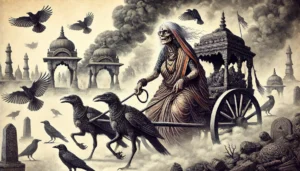
Dhumavati Devi is unique in Hinduism due to her portrayal as an elderly widow, signifying the loss of auspiciousness. In contrast to other goddesses who are often depicted as youthful, beautiful, and full of life, Dhumavati Devi embodies inauspiciousness and the dissolution of all worldly ties. While this may seem grim, Dhumavati Devi’s power lies in her ability to help devotees transcend attachment to the material world, leading them toward the ultimate spiritual truth.
The Mythological Origins of Dhumavati Devi
Dhumavati Devi’s myth begins with her incarnation as Parvati, the consort of Shiva. According to legend, Parvati was once overwhelmed by an intense hunger and asked Shiva to provide food. When Shiva hesitated, Parvati’s hunger consumed her, and in her desperation, she swallowed Shiva whole. Enraged by this act, Shiva cursed her, transforming her into a widow and severing their marital bond. From this moment on, Parvati became Dhumavati Devi, the widow goddess of misfortune and the void.
Starting Sentence: In Hindu mythology, Dhumavati Devi’s origin story reveals her as Parvati, who, driven by hunger, swallowed her husband Shiva, resulting in her transformation into a widow goddess.
This transformation reflects Dhumavati Devi’s power to exist outside conventional social roles. As a widow, she is no longer defined by her relationship to others—she is complete in herself. Her form symbolizes the wisdom that arises from the experience of loss and the dissolution of worldly attachments.
Her Iconography: The Symbols of Dhumavati Devi
Dhumavati Devi’s appearance is a visual representation of her connection to loss, dissolution, and detachment. She is depicted as an old, gaunt woman, often with disheveled hair and wearing ragged clothing. Her chariot, drawn by crows, reflects her association with death and the afterlife, as crows are often considered messengers between the worlds of the living and the dead.
Starting Sentence: Dhumavati Devi’s depiction—a frail, elderly woman riding a crow-drawn chariot—serves as a potent reminder of life’s transient nature and the wisdom that comes from accepting impermanence.
The smoke that often surrounds Dhumavati Devi symbolizes the ephemeral nature of existence. Smoke, which can cloud vision and quickly dissipate, represents how temporary and illusory the material world truly is. Through her stark appearance, Dhumavati Devi challenges her devotees to look beyond the superficial aspects of life and focus on the eternal truth beneath.
Dhumavati Devi’s Powers: Embracing Misfortune to Find Wisdom
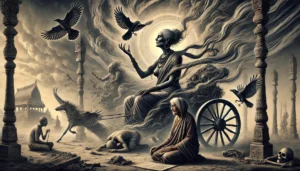
Dhumavati Devi’s power lies in her ability to confront us with the truths we often try to avoid—misfortune, loss, and the inevitable end of all things. However, she does not represent these forces as negative; rather, she teaches that embracing these aspects of existence is essential for spiritual growth and inner peace.
The Void in Dhumavati Devi’s Teachings
In Hindu philosophy, the void—referred to as “shunya”—is not a place of emptiness in the negative sense, but a state of infinite possibility. Dhumavati Devi embodies this concept of the void, symbolizing the space that remains after everything has been stripped away. In this space, devotees can discover the ultimate truth and realize the impermanence of the material world.
Starting Sentence: Dhumavati Devi’s teachings emphasize that the void is not to be feared; it is, in fact, a space where one can find the ultimate spiritual truth.
Her energy urges us to let go of attachments and illusions, offering a path to transcend the dualities of life and death, gain and loss, and good and bad. Through the void, devotees can connect with the infinite and eternal consciousness that lies beyond all forms.
Misfortune as a Tool for Spiritual Freedom
Dhumavati Devi’s association with misfortune is not meant to inspire fear or dread. Instead, she uses misfortune as a means of awakening her devotees to the deeper truths of existence. By experiencing hardship and loss, devotees are forced to confront their attachments and the fleeting nature of worldly pleasures.
Starting Sentence: Dhumavati Devi teaches that misfortune is not a curse, but a tool that can help us break free from our attachments to material life and achieve spiritual growth.
Through her guidance, devotees learn that suffering is an opportunity to develop resilience and wisdom. It is through hardship that they can shed their attachments to material desires and see life’s impermanence with clarity. Ultimately, Dhumavati Devi helps her followers find strength in adversity, leading them to deeper spiritual realization.
Dhumavati Devi Compared to Other Dasha Mahavidyas

Among the Dasha Mahavidyas, Dhumavati Devi holds a distinctive role due to her focus on dissolution and misfortune. While other goddesses within the Mahavidya tradition are associated with creation, protection, or transformation, Dhumavati Devi stands apart as the goddess who teaches through the experience of loss and emptiness.
Dhumavati Devi’s Unique Role among the Mahavidyas
The Dasha Mahavidyas represent various forms of the divine feminine, each reflecting a different path to spiritual realization. While goddesses like Kali and Tara symbolize empowerment, strength, and compassion, Dhumavati represents a different form of power—the power that comes from embracing inauspiciousness and detachment.
Starting Sentence: While goddesses like Kali and Tara are known for their fierce protection and compassion, Dhumavati’s strength lies in her ability to guide her followers through life’s harshest truths.
Dhumavati’s role is to help devotees transcend the dualities of life by realizing that all forms are temporary. Through her teachings, devotees can learn that true freedom lies in accepting the impermanence of all things and embracing the void.
Wisdom through Suffering in Dhumavati’s Path
Whereas many deities offer blessings and protection, Dhumavati provides wisdom through suffering. Her devotees understand that to grow spiritually, they must first face life’s challenges and learn to let go of material attachments.
Starting Sentence: In Dhumavati’s path, wisdom is gained not through ease or grace, but through the process of enduring hardship and learning to detach from the fleeting pleasures of life.
For those who follow her, suffering becomes a tool for spiritual awakening. The more they endure, the more they can see through the illusions of the material world. In this way, Dhumavati’s devotees find clarity and inner strength.
Temples Dedicated to Dhumavati Devi
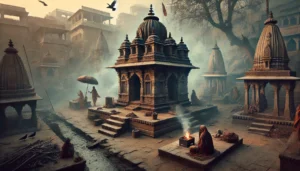
Despite being associated with inauspiciousness, Dhumavati has temples where devotees come to seek her blessings. These temples offer a space for those who are ready to embrace her energy and overcome life’s challenges through her teachings.
The Dhumavati Temple in Varanasi
One of the most significant temples dedicated to Dhumavati is located in Varanasi, a city closely associated with death and spiritual liberation. Known as a place where life and death converge, Varanasi is a fitting location for Dhumavati’s temple. Here, devotees come to confront the realities of impermanence and seek spiritual growth.
Starting Sentence: The Dhumavati Temple in Varanasi stands as a sacred space where devotees come to invoke the goddess’s transformative power and overcome the obstacles in their lives.
The temple, while small, holds immense significance for tantric practitioners. Many come here to perform rituals aimed at dissolving obstacles and breaking through the illusions of material existence. It is a place where the energy of Dhumavati is said to be particularly strong, making it a powerful site for those seeking spiritual transformation.
The Significance of Dhumavati Shrines in Tantra
Dhumavati shrines are often found in isolated locations or near cremation grounds, places that resonate with her energy of dissolution. These sites hold special importance in tantric practices, as they are believed to be locations where the boundaries between the physical and spiritual worlds are thin.
Starting Sentence: Dhumavati’s connection to cremation grounds reflects her role in tantra, where dissolution and death are viewed as gateways to spiritual enlightenment.
For tantric practitioners, these shrines offer a space to engage in deep spiritual practice. Through rituals performed at these shrines, devotees seek to transcend the limitations of the material world and achieve spiritual liberation.
Dhumavati Devi Sadhana: The Path of Transformation
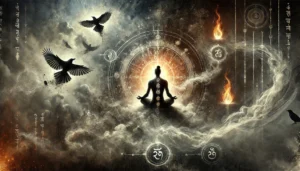
Dhumavati Sadhana is a powerful tantric practice that allows devotees to invoke the goddess’s energy and gain insight through hardship. It is a path that requires deep commitment and a willingness to face life’s challenges head-on.
What is Dhumavati Sadhana?
Dhumavati Sadhana is a tantric practice designed to help devotees align with the goddess’s transformative energy. This practice often involves chanting her mantras, performing rituals, and meditating on her form, with the goal of transcending worldly attachments and gaining spiritual clarity.
Starting Sentence: Dhumavati Sadhana is a focused spiritual practice that involves chanting her mantras, meditating on her form, and performing rituals to invoke her presence.
Practitioners often undertake this sadhana during times of personal hardship, seeking Dhumavati’s guidance to overcome obstacles. The practice is not simply about seeking relief from suffering, but about using suffering as a tool for spiritual growth and transformation.
Rituals in Dhumavati Sadhana
The rituals involved in Dhumavati Sadhana vary, but they often include reciting her mantra, “Dhum Dhum Dhumavati Svaha,” and making offerings that symbolize the dissolution of ego and attachment. These rituals are typically performed in sacred spaces, such as her temples or cremation grounds, where her energy is believed to be especially strong.
Starting Sentence: Dhumavati Sadhana requires specific rituals, such as the recitation of her powerful mantra and offerings that help practitioners align with her energy of dissolution.
By performing these rituals, practitioners seek to break free from the illusions of the material world and connect with the eternal, formless consciousness that Dhumavati represents.
Benefits of Dhumavati Sadhana
While Dhumavati Sadhana is challenging, the benefits for those who practice it with dedication are immense. Devotees often report a deeper sense of peace, clarity, and inner strength after completing the sadhana. The hardships they endure become opportunities for growth, allowing them to gain a greater understanding of life’s impermanence.
Starting Sentence: The rewards of Dhumavati Sadhana are profound, offering devotees the opportunity to overcome misfortune, gain wisdom, and achieve spiritual liberation.
Through Dhumavati’s guidance, practitioners learn to transcend suffering and illusion, ultimately achieving a state of inner peace and spiritual freedom.
Dhumavati Devi Mantras and Worship Practices
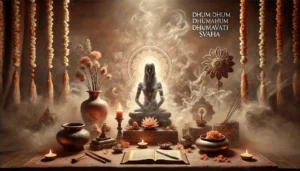
Mantras are an essential part of Dhumavati worship, helping devotees connect with her energy and invoke her transformative power. By chanting her mantra, devotees can align themselves with her teachings and gain her blessings.
The Power of the Dhumavati Mantra
The primary mantra used in Dhumavati’s worship is:
“Dhum Dhum Dhumavati Svaha”
Starting Sentence: The mantra “Dhum Dhum Dhumavati Svaha” is a powerful tool for invoking the goddess’s presence and gaining her blessings.
Chanting this mantra helps focus the mind, allowing devotees to tap into Dhumavati’s energy of dissolution. The vibrations created by this mantra are believed to dissolve obstacles and bring clarity in times of difficulty.
Dhumavati Devi Temples and Their Role in Tantra
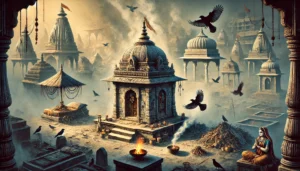
Temples dedicated to Dhumavati hold immense importance in tantric practices. These sacred spaces allow devotees to perform rituals that align them with her energy and help them transcend worldly attachments.
The Power of Worshipping Dhumavati in Her Temples
For tantric practitioners, worshipping Dhumavati in her temples is a powerful way to access her transformative energy. These temples provide a space where devotees can perform rituals, align with her teachings, and seek spiritual liberation.
Starting Sentence: Dhumavati’s temples offer a unique opportunity for devotees to engage with her transformative power and gain spiritual insight through the rituals performed there.
In these temples, devotees are encouraged to face life’s darker aspects and embrace the void, leading to greater spiritual growth and understanding.
The Transformative Power of Worshipping Dhumavati Devi
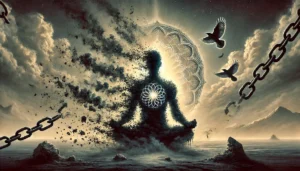
Worshipping Dhumavati leads to profound transformation for those willing to embrace her teachings. Through her, devotees can overcome life’s greatest challenges and achieve spiritual freedom by detaching from the illusions of the material world.
The Path to Liberation through Dhumavati
Dhumavati offers her devotees a path to liberation that requires them to confront life’s harshest realities. By worshipping her, they can transcend the cycle of birth and death, ultimately achieving moksha or spiritual liberation.
Starting Sentence: Dhumavati’s teachings offer a path to spiritual liberation through detachment from material desires and the realization of life’s impermanence.
Her blessings help devotees develop the strength and clarity necessary to navigate life’s challenges with grace and achieve inner peace.
Conclusion: Dhumavati as a Guide to Inner Liberation
Dhumavati, the widow goddess of misfortune and the void, may seem daunting at first, but for those who follow her path, she offers profound spiritual growth and liberation. By confronting life’s darker aspects and embracing the void, devotees can find wisdom, inner peace, and ultimately, freedom from the illusions of the material world.
Starting Sentence: Though Dhumavati represents the darker side of existence, her teachings guide devotees toward wisdom, peace, and the ultimate liberation from worldly attachments.
FAQ: Frequently Asked Questions about Dhumavati
1. What does Dhumavati represent?
Dhumavati symbolizes misfortune, dissolution, and the void, embodying the darker aspects of life. She teaches that facing these realities can lead to spiritual wisdom.
2. Why is Dhumavati depicted as a widow?
Dhumavati is depicted as a widow because, in her myth, she was cursed to live without Shiva. Her widowhood symbolizes detachment from worldly relationships and attachments.
3. What are the benefits of worshipping Dhumavati?
Worshipping Dhumavati helps devotees overcome obstacles, breakthrough illusions, and gain deeper wisdom. Her blessings provide strength and spiritual clarity during times of hardship.
4. What is Dhumavati Sadhana?
Dhumavati Sadhana is a tantric practice involving mantra chanting, rituals, and meditation. It helps devotees transcend worldly attachments and gain spiritual insight.
5. Where are Dhumavati’s temples located?
One of the most well-known Dhumavati temples is located in Varanasi, India. Her shrines are often found near cremation grounds, where her energy of dissolution is especially potent.


















